Look for Elegant Cedar Waxwing Birds in Berry Trees
Updated: Sep. 14, 2022
Built for gobbling fruit, cedar waxwings are striking, social birds. Learn how to spot these elegant birds.
What Does a Cedar Waxwing Bird Look Like?
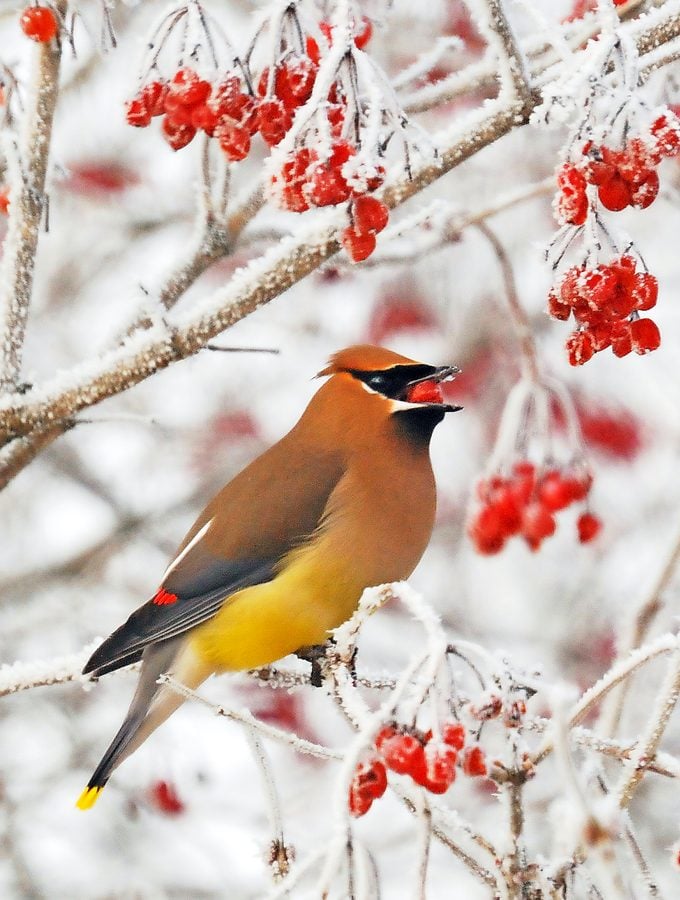
With bright pops of color, bold markings and a slim, shiny body, a cedar waxwing bird is a sight to behold. Their behavior is exciting to watch, and they snatch berries in their bills before swallowing them whole—sometimes while hovering underneath a branch.
Waxwings sport sleek bodies with black masks over their eyes and a prominent tan crest atop their heads. The coloring of males and females is nearly identical. These distinctive birds are slightly smaller than a robin, with a large head and a short wide bill. Their wings are light gray, bellies are a soft yellow and tails have a bright yellow tip.
“People love cedar waxwings because they are just so elegant,” says ornithologist Kevin McGowan of the Cornell Lab of Ornithology, one of the developers of the All About Birds website.
Bohemian waxwing vs cedar waxwing: learn how to tell the difference.
Wax on Their Wings
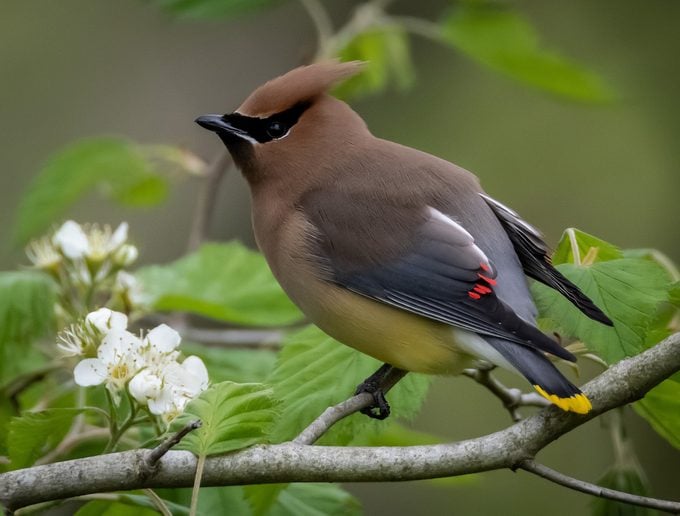
Not only striking but true to their name, cedar waxwings produce wax deposits on their wings. Small droplets of red wax rest on the tips of their secondary feathers. The wax is ornamental, and eventually it wears or breaks off.
Experts can only guess what purpose it serves. One speculation is about health and fitness. “In the bird world, there tend to be things like this that indicate if you’re really good at taking care of yourself, you’re really good at finding food, or being vigorous,” Kevin says. “There are a lot of signals of doing well, or not doing so well, that have survival value.”
Some rare cedar waxwings have orange tail tips from eating a certain nonnative honeysuckle.
Cedar Waxwing Facts
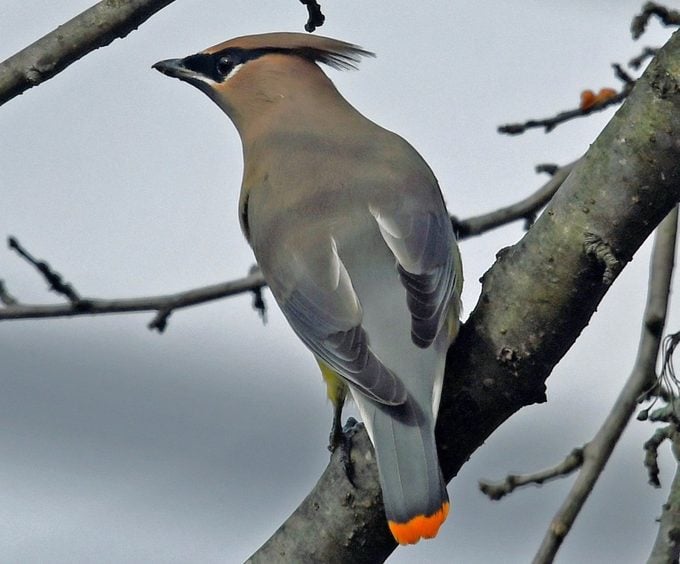
Scientific Name: Bombycilla cedrorum
Family: Waxwing
Length: 7 inches
Wingspan: 12 inches
Nest and Eggs
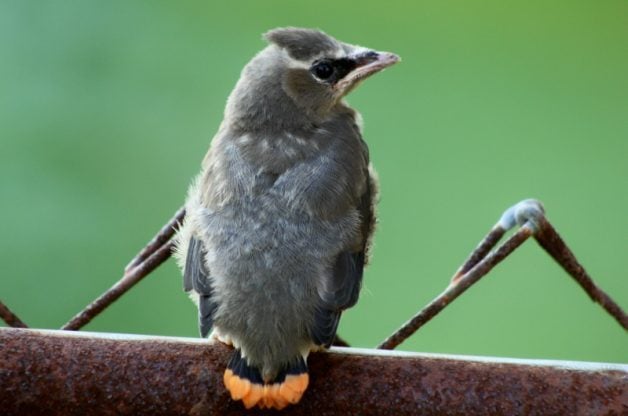
The female waxwing lays four to five pale-gray eggs with black spots in a bulky nest made of plant materials, string, horsehair and other ephemera. They nest in trees and bushes, often by open water.
Learn more about cedar waxwing baby birds and nests.
Cedar Waxwing Diet
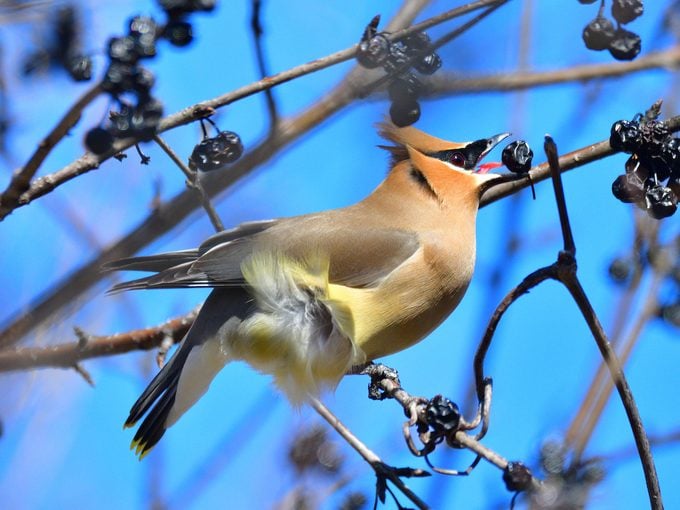
These feathered friends rarely use feeders, as they are highly adapted to feed on fruit. Attract them by planting a small fruiting tree or shrub in your yard. Go the extra mile to make sure what you plant is native to your area, as it’ll have the most nutritional value for the birds.
You might see a row of sociable cedar waxwings perched on a branch, passing a berry down the line and back, in a ceremony that ends when one eats the food.
The best wide-ranging native options include serviceberries, Juneberries, dogwoods and shadberries. Cedar waxwings also snack on strawberries, crabapples, hawthorns and juniper berries. Junipers are coniferous plants and often are given the common name “cedar,” which is how this bird gets its moniker.
During the breeding season, waxwings add insects to their diet, often swooping out from treetops to catch them in midair.
“Waxwings frequent our apple trees in the spring and share the blossoms with each other as part of their courtship display,” says Sue Gronholz of Beaver Dam, Wisconsin.
Learn more about what cedar waxwings eat.
Cedar Waxwing Call and Song
Their voice is an irregular rhythm of high “sreee” notes. Listen to the cedar waxwing’s song.
Bird songs provided by the Cornell Lab of Ornithology.
Range Map
To spot a cedar waxwing, look for a flock. Social birds, waxwings are often in a crowd of five to 50, with groups swelling in the winter, up to 200. You can find them throughout the year in the northern half of the United States and in the southern U.S. during non-breeding months. Their preferred habitat is backyards, parks and open woodlands. Learn more about cedar waxwing migration.
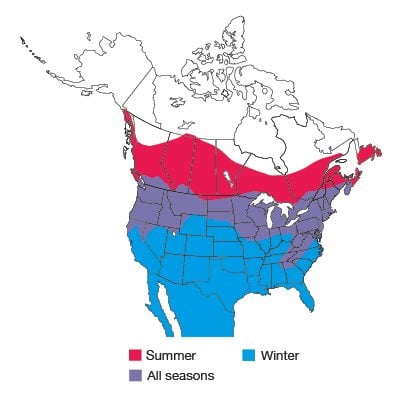
Range maps provided by Kaufman Field Guides, the official field guide of Birds & Blooms.
